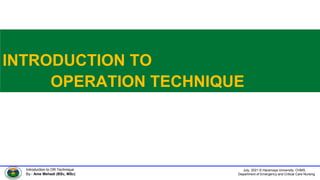The document provides information about operating room organization and design. It discusses the objective of describing specific OR areas, equipment, environmental layout, personnel, and aseptic technique principles. It defines key terms like operating department, operating suite, and operating theater. It describes the major considerations for OR design which include doors, lighting, ventilation, humidity, and heating. The basic design principles are outlined, including having a simple cleanable design, separate clean and soiled instrument rooms, and sufficient space. Specific organizational areas in the OR are also detailed.


















































![July, 2021 © Haramaya University, CHMS,
Department of Emergency and Critical Care Nursing
Introduction to OR Technique
By:- Ame Mehadi (BSc, MSc)
Materials required in RR
Emergency drugs
►Adrenaline
►Analgesics like morphine
►Anti-emetic drugs
Chlorpromazine
Promethazine
►Anticholinergic drugs like atropine
decrease secretion, increase HR
►Sodium bicarbonate –for acidosis
IV fluids
a. Crystalloids – are fluids with lower
molecular weight.
►e.g.
► 5% DW [sugar + water]
► 0.9% NS [salt + water]
► 5% DNS [sugar + salt]
► R/L [water + electrolytes-k, Ca, Mg etc.
b. Colloids – are fluids with higher
molecular weight
► Are plasma expanders –used for
hemorrhagic (bleeding) pts.
e.g. Dextran, plander, plasmin.](https://image.slidesharecdn.com/1-240212225425-9ed2a458/85/1-Introduction-ORT-pptx-51-320.jpg)